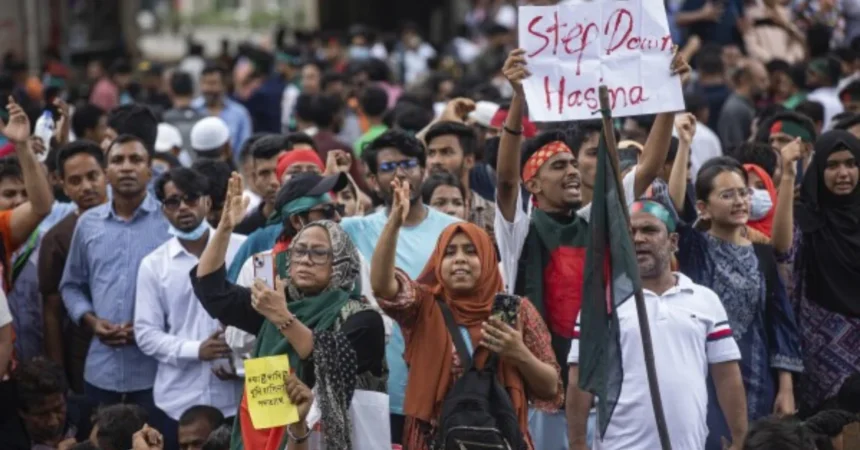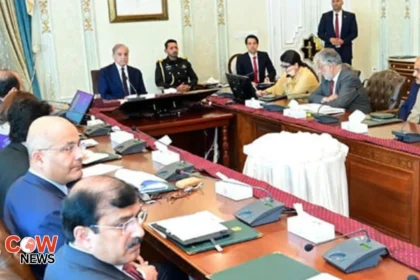Protests erupted outside the residence of Bangladeshi President Mohammed Shahabuddin in Dhaka, leading to violent clashes with police that left approximately 30 people injured. The demonstrators, fueled by frustration over perceived political remnants from the previous regime, are demanding Shahabuddin’s resignation, viewing him as a symbol of the autocratic rule that has characterized the country’s recent history.
Background of Political Unrest
The current unrest in Bangladesh is deeply rooted in the political turmoil that has plagued the country for years. Former Prime Minister Sheikh Hasina’s administration, which was marked by allegations of authoritarianism and widespread corruption, was toppled during a significant student-led uprising in August. This movement culminated in Hasina fleeing to India, leaving behind a power vacuum and a populace eager for change.
President Shahabuddin, while holding a largely ceremonial role, has come under scrutiny for his ties to Hasina’s government. He played a crucial part in the political landscape during the upheaval, raising concerns among protesters about his loyalty to the ousted leader and her Awami League party.
In a recent media interview, Shahabuddin suggested he had not seen a formal resignation letter from Hasina, which raised questions regarding the legitimacy of her exit from power. This remark has only intensified the demands for his resignation, with many protesters accusing him of harboring residual loyalty to Hasina’s regime.
Escalation of Protests
The protests began to gain traction as citizens expressed their dissatisfaction with the transitional government. On Tuesday, demonstrators gathered outside Shahabuddin’s residence, chanting slogans and demanding his immediate resignation. The tension escalated late Wednesday night when hundreds of protesters attempted to breach security barriers surrounding the presidential compound.
In the chaos that ensued, clashes broke out between protesters and riot police. The police, equipped with shields and batons, attempted to control the crowd, leading to a violent confrontation. Reports indicate that at least 25 police officers sustained injuries during the clashes, with several requiring medical attention. Demonstrators hurled stones and engaged in skirmishes, illustrating the heightened emotions surrounding the protest.
Injuries and Casualties
Medical personnel at Dhaka Medical College Hospital confirmed that five individuals, including three protesters and two journalists, were treated for injuries incurred during the clashes. Witnesses described scenes of chaos, with protesters rallying to demand a leader who represents the people’s will rather than the remnants of a discredited regime.
The situation highlighted the fragile state of public safety as the government grapples with widespread discontent. As tensions simmer, the authorities have reinforced security measures around key locations in the capital to prevent further escalations.
The Role of Student Activism
Student activism has emerged as a driving force behind the recent political changes in Bangladesh. Groups like Students Against Discrimination have galvanized support among youth, who are increasingly vocal about their demands for accountability and reform. These students played a pivotal role in the protests that led to Hasina’s ouster, and they continue to advocate for a government that reflects the aspirations of the Bangladeshi populace.
Faruk Hossain, a student leader, articulated the sentiment shared by many demonstrators: “Since the student-led protest toppled the fascist regime, there shouldn’t be a president from that regime.” This assertion encapsulates the desire for a new political paradigm that prioritizes the voices of ordinary citizens.
The protests have also sparked discussions about the future of governance in Bangladesh. Activists are calling for a “people’s president” who genuinely represents the will of the people, emphasizing the need for political leaders to prioritize public interests over party loyalty.
Political Ramifications
The protests have significant implications for Bangladesh’s political landscape. Following the ousting of Hasina, several officials loyal to her administration have been removed from their positions, including Supreme Court justices and the central bank chief. These purges often followed direct action from student-led protests, indicating a coordinated effort to dismantle the previous regime’s influence.
The growing unrest and demands for a new leadership structure underscore the populace’s desire for transparency and accountability in governance. Political analysts suggest that the current administration, under Shahabuddin, may face increasing pressure to address these demands or risk further destabilizing the country.
Responses from Authorities
In response to the protests, law enforcement officials have pledged to maintain order and protect public safety. Deputy Commissioner Talebur Rahman confirmed that adequate security measures have been put in place following the clashes, and authorities remain on high alert for any further disturbances.
Local media coverage of the events has been extensive, with journalists documenting the protests and the response from law enforcement. However, the treatment of journalists at the protests has also raised concerns about press freedom, as media personnel have faced hostility during the demonstrations.
Community Reactions and Solidarity
The protests have resonated beyond the immediate vicinity of the presidential compound, with solidarity demonstrations occurring in other cities across Bangladesh. Citizens from various walks of life have joined the calls for Shahabuddin’s resignation, signaling a widespread discontent with the current political arrangement.
Public sentiment is increasingly aligning with the demands of student activists, reflecting a broader movement for change within the country. Social media has played a crucial role in mobilizing support, with hashtags related to the protests trending on various platforms, amplifying the voices of those demanding reform.
Future of the Movement
As the protests continue, the leadership of the student movements will be crucial in determining the future trajectory of this uprising. Activists have expressed their commitment to strategic planning and engagement with political parties, aiming to establish a consensus candidate to replace Shahabuddin.
Hasnat Abdullah, another student leader, emphasized the importance of maintaining composure and strategy during this critical time. “If emotion takes over strategy, the country will suffer,” he stated, urging protesters to remain focused on their goals.
The upcoming discussions with political leaders and military officials will be pivotal in shaping the course of the protests. Activists are advocating for a new political framework that includes greater representation and accountability, aiming to build a government that genuinely reflects the will of the people.
International Implications
The unrest in Bangladesh has drawn the attention of international observers, who are monitoring the situation closely. The country’s political stability is crucial not only for its citizens but also for regional security and economic development. As protests continue, foreign governments and organizations may reassess their diplomatic and economic ties to Bangladesh, particularly if the situation escalates further.
The international community’s response will depend on the government’s actions in the coming days. If authorities take steps to address the protesters’ demands, it could lead to a de-escalation of tensions. Conversely, a heavy-handed approach could result in widespread condemnation and potential sanctions.
The protests demanding President Mohammed Shahabuddin’s resignation highlight a critical moment in Bangladesh’s political landscape. Fueled by widespread dissatisfaction with the remnants of the previous regime, citizens, particularly the youth, are calling for a government that truly represents their interests. The ongoing clashes with police underscore the volatility of the situation and the urgent need for dialogue and reform.
As activists rally for change, the eyes of the nation—and the world—are watching closely, awaiting the next steps in this evolving political narrative. The outcome of these protests will undoubtedly shape the future of governance in Bangladesh and could have far-reaching implications for the region.
#BangladeshProtests #ShahabuddinResignation #PoliticalChange #StudentActivism #Dhaka #SheikhHasina #Democracy #CivilRights







